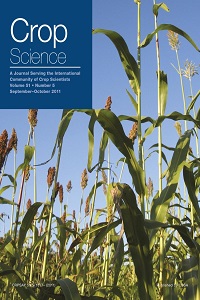MlUM15: an Aegilops neglecta-derived powdery mildew resistance gene in common wheat
Powdery mildew, caused by Blumeria graminis f. sp. tritici, is a major fungal disease of wheat (Triticum aestivum L.). Host plant resistance is a reliable, economical, and environmentally benign form of disease prevention. The identification of molecular markers linked with resistance genes can facilitate marker‐assisted selection and enable breeders to pyramid several major genes for powdery mildew resistance in a single cultivar. The wheat germplasm line NC09BGTUM15 (NC‐UM15) possesses the first powdery mildew resistance gene introgressed from Aegilops neglecta Req. ex Bertol. Greenhouse and field evaluations of F2:3 families derived from a cross between NC‐UM15 and the susceptible cultivar ‘Saluda’ indicated that a single dominant gene, temporarily designated MlUM15, conferred resistance to powdery mildew. Bulked segregant analysis (BSA) showed that several simple sequence repeat (SSR), sequence tag site (STS), and single nucleotide polymorphism (SNP) markers specific to chromosome 7AL segregated with the resistance gene. The most likely marker order was Xwmc525/IWA8057‐0.7 cM‐Xcfa2257‐0.4 cM‐ MlUM15 −0.8 cM‐Xcfa2240‐2.8 cM‐Xmag2185‐3.4cM‐IWA2929‐5.4 cM‐ IWA4434. The multiallelic Pm1 locus and several temporarily‐designated genes map to this region of chromosome 7AL. Detached‐leaf tests revealed that NC‐UM15 had a different disease response pattern from genotypes carrying Pm37, five temporarily‐designed genes in the region, and all alleles of the Pm1 complex except Pm1b. The MlUM15‐resistance gene is most likely a novel source of powdery mildew resistance. However, allelism tests with Pm1 and further detached‐leaf tests will be required to elucidate the relationship between MlUM15 and other Pm loci in the distal region of 7AL.

